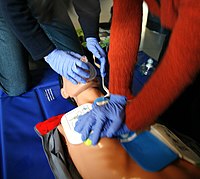
Photo from wikipedia
Abstract Vascular compression of the airway is an uncommon condition that needs to be diagnosed and treated early. In many cases involving children with congenital heart disease (CHD), vascular compression… Click to show full abstract
Abstract Vascular compression of the airway is an uncommon condition that needs to be diagnosed and treated early. In many cases involving children with congenital heart disease (CHD), vascular compression of the airway is a significant cause of morbidity. The most common congenital anomalies associated with airway compression are vascular rings (VR). Other causes would include enlargement of the aorta, pulmonary artery, and cardiac chambers as a result of underlying cardiac lesions or following cardiac intervention. The diagnosis remains challenging, as the clinical presentation of vascular compression of the airways can be variable and non-specific. Therefore, in children with CHD, a high index of suspicion of possible vascular compression of the airway is essential in any patient experiencing persistent respiratory symptoms or feeding difficulty to avoid inevitable delays in diagnosis. On the other hand, prenatal detection of the vascular ring has increased significantly over the years that allows detection even in asymptomatic cases. The issue may arise from the prenatal detection of asymptomatic patients that may lead to overtreatment and operating on mildly symptomatic patients. Replacing esophagography and angiography, Magnetic resonance imaging (MRI) and cardiac computed tomography (CT) angiography are a commonly used tool for confirmation of diagnosis and pre-operative planning. The management of vascular compression of the airway in children with CHD can be equally challenging as complications might arise and affect CHD and obstructive airway disease or vice versa. The recommended treatment for symptomatic patients with VR or pulmonary artery (PA) sling is surgical repair. Careful surgical planning with a good pre-operative and post-operative airway management is essential to ensure successful treatment.
Journal Title: Progress in Pediatric Cardiology
Year Published: 2020
Link to full text (if available)
Share on Social Media: Sign Up to like & get
recommendations!